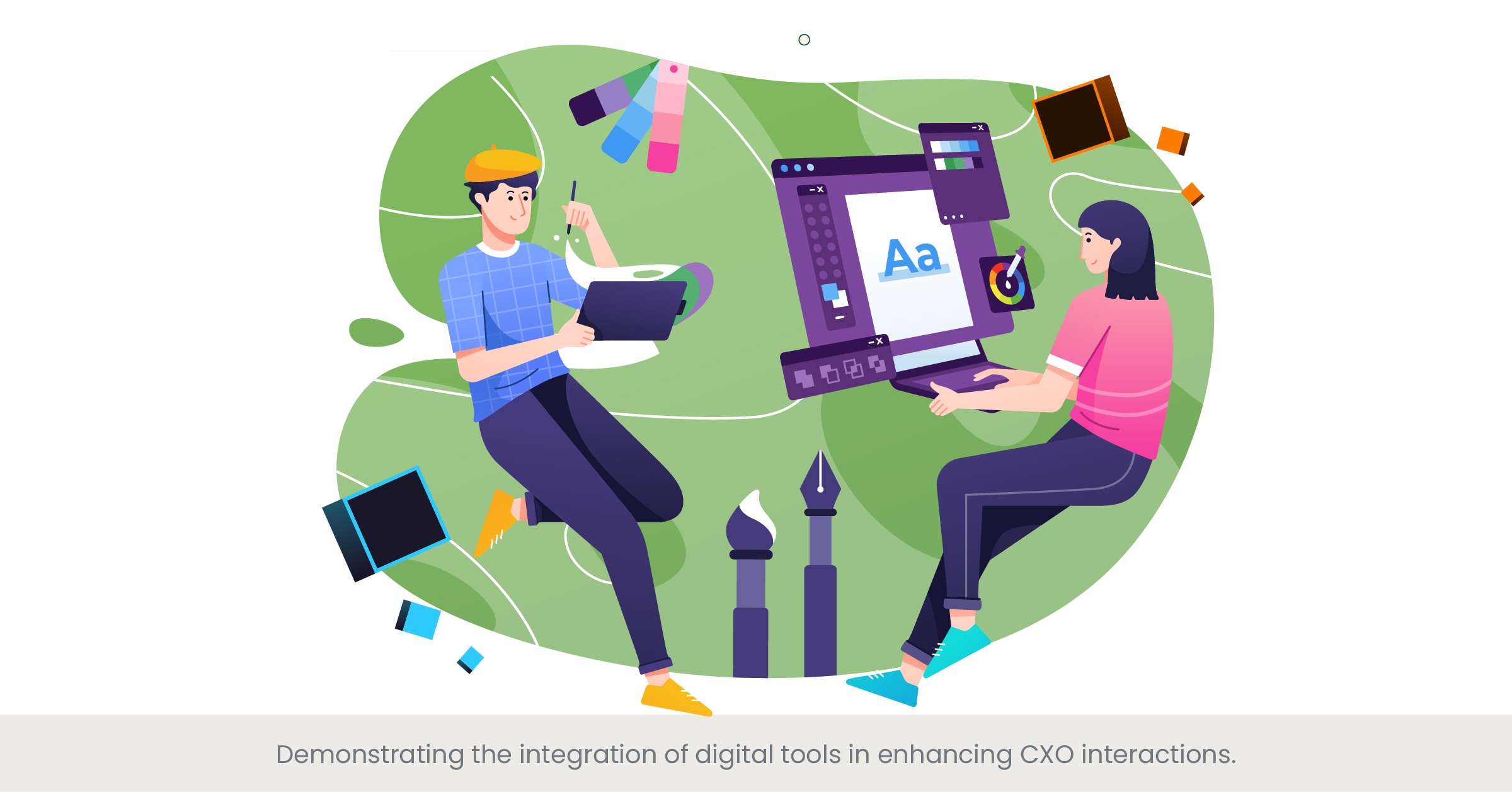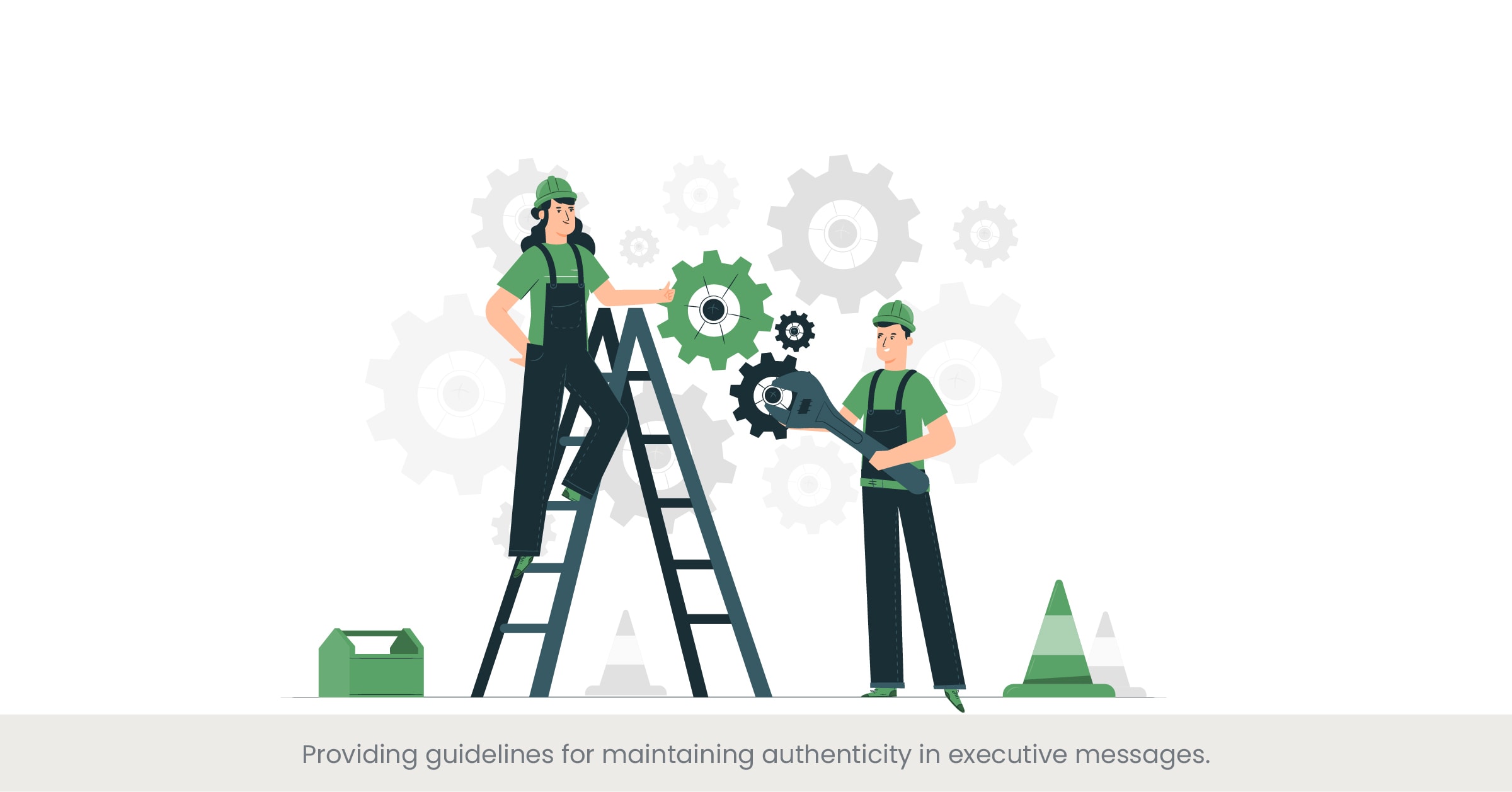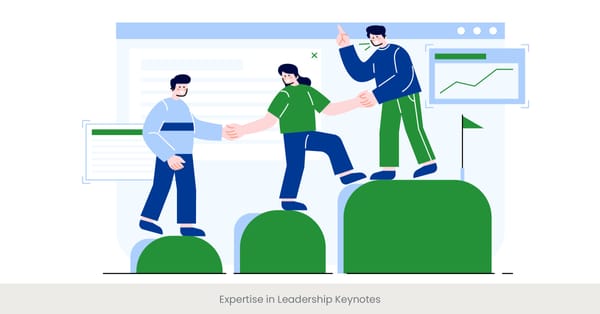
Offering Strategies for Improving Clarity and Impact in CXO Communications

Introduction to Improving Clarity and Impact
Effective communication is essential for CXOs to lead their organizations successfully. Clear and impactful messaging can inspire teams, align stakeholders, and drive business objectives. The role of a CXO Presentation Design Expert is crucial in crafting presentations that not only convey information but also engage and motivate the audience. Leadership event presentations need to be meticulously designed to ensure clarity and impact, enabling leaders to communicate their vision and strategy effectively. This section explores various strategies that CXOs can employ to enhance the clarity and impact of their communications.
Background on Communication Strategies
Clarity in communication involves simplifying complex ideas and presenting them in a structured manner. This includes the use of logical flow, data visualization, and effective storytelling techniques. Impactful communication, on the other hand, is about connecting with the audience on an emotional level and motivating them to take action. Strategies for improving clarity and impact include defining clear objectives, understanding the audience's needs, and using engaging visuals and narratives. The expertise of leadership presentation experts is invaluable in this process, as they bring a wealth of knowledge and experience in crafting remarkable presentations that resonate with audience members.
Real-World Examples of Effective Communication
Consider the leadership keynote delivered by a CEO at a major technology conference. The presentation, designed by a renowned CXO Presentation Design Expert, utilized data visualization to simplify complex technological advancements and their implications. The logical flow of the presentation ensured that the audience could easily follow and understand the key messages. Another example is the annual leadership event presentation by a financial services firm’s CXO, which employed storytelling to highlight the company’s journey and future goals. These real-world instances demonstrate how strategic communication can enhance clarity and impact, making the presentations not only effective solution not only informative but also inspiring.
References and Validation
Research supports the importance of clarity and impact in executive communications. A study by the Harvard Business Review found that presentations with clear objectives and well-structured content are 40% more effective in engaging the audience. Additionally, data from the Presentation Guild indicates that the use of professional presentation design can increase audience retention by up to 50%. Agencies like Duarte and Ethos3 have documented numerous case studies where their expertise in presentation design has significantly improved the clarity and impact of CXO communications. These findings validate the effectiveness of employing strategic communication techniques in leadership presentations.
Discussing the Role of Consistency in CXO Messaging Across Platforms

Introduction to Consistency in CXO Messaging
Consistency in messaging is vital for CXOs to build trust and credibility with their audience. Whether delivering a speech at a leadership event, communicating via digital platforms, or presenting at board meetings, consistent messaging ensures that the core values and strategic vision of the organization are reinforced across all touchpoints. Leadership presentation experts play a crucial role in maintaining this consistency, helping CXOs craft messages that align with the organization's brand and resonate with different audience members. This section delves into the importance of consistency in CXO messaging and how it can be effectively achieved.
Background on Consistent Messaging
Consistent messaging involves aligning all communications with the organization's mission, vision, and values. This requires a clear understanding of the brand's voice and strategic goals. Consistency helps in reinforcing the key messages, making them more memorable and impactful. Leadership team members must ensure that the content, tone, and style of communication are uniform across various platforms, including presentations, social media, and internal communications. This alignment builds a coherent narrative that strengthens the organization’s identity and fosters trust among stakeholders.
Real-World Examples of Consistent Messaging
A notable example of effective consistent messaging is the communications strategy employed by Apple’s leadership team. Whether through keynote presentations, press releases, or social media updates, Apple maintains a consistent brand voice that emphasizes innovation, simplicity, and user experience. This uniformity helps reinforce Apple’s brand identity and strategic vision. Similarly, Microsoft’s leadership event presentations consistently highlight themes of empowerment and digital transformation, creating a cohesive narrative that aligns with the company’s mission. These examples illustrate how consistent messaging across platforms can enhance the impact of CXO communications.
References and Validation
Studies highlight the benefits of consistent messaging in enhancing brand perception and audience trust. According to research by McKinsey & Company, organizations with consistent messaging across all platforms see a 33% increase in brand loyalty. Additionally, a report by the Nielsen Norman Group indicates that consistent communication strategies can improve audience recall and engagement by 40%. Agencies such as Duarte and Ethos3 have extensive experience in helping organizations achieve consistency in their messaging practices, with numerous case studies demonstrating the positive impact on audience perception and engagement. These findings underscore the importance of maintaining uniformity in CXO communications to build trust and reinforce the brand’s strategic vision.
Highlighting How Agencies Can Streamline Communication Strategies

Introduction to Streamlining Communication Strategies
Streamlining communication strategies is essential for ensuring that CXO messages are clear, concise, and impactful. Specialized agencies play a pivotal role in this process, helping leaders develop and deliver presentations that resonate with their audience. By leveraging the expertise of a CXO Presentation Design Expert, organizations can simplify complex information, enhance the logical flow of presentations, and ensure that key messages are effectively communicated. This section explores how agencies can streamline communication strategies to enhance the effectiveness of leadership event presentations.
Background on Streamlined Communication
Streamlining communication involves reducing complexity and focusing on the most critical messages. This process includes simplifying data, refining narratives, and ensuring a logical flow throughout the presentation. Leadership presentation experts collaborate with CXOs to identify the core objectives of the presentation and develop content that aligns with these goals. Techniques such as data visualization and storytelling are employed to make complex information more accessible and engaging. By streamlining communication strategies, agencies help CXOs deliver clear and impactful messages that are easy for the audience to understand and remember.
Real-World Examples of Streamlined Strategies
One example of streamlined communication strategies can be seen in the presentations developed for a leading healthcare company by a renowned presentation agency. The agency worked with the company’s leadership team to simplify complex medical data using clear visuals and concise narratives. This approach not only enhanced the clarity of the presentation but also increased audience engagement. Another example is a financial services firm that partnered with a CXO Presentation Design Expert to refine their annual leadership event presentation. By focusing on key messages and using the most effective solution communication techniques, the agency helped the firm deliver a more cohesive and impactful presentation. These examples highlight the benefits of streamlined communication strategies in enhancing the effectiveness of CXO communications.
References and Validation
Research supports the benefits of streamlined communication strategies in improving audience engagement and message retention. According to a study by the Journal of Business Communication, presentations that are clear and concise are 50% more likely to be remembered by the audience. Additionally, a report by the Harvard Business Review indicates that simplified communication strategies can lead to better decision-making and increased stakeholder buy-in. Agencies like Duarte and Ethos3 have documented numerous case studies demonstrating the positive impact of streamlined communication on leadership presentations. These findings validate the importance of working with expert agencies to enhance the clarity and impact of CXO communications.
Exploring Advanced Techniques for Persuasive Executive Communications

Introduction to Persuasive Executive Communications
Persuasive executive communications are critical for influencing decision-making and driving strategic initiatives. Advanced techniques in crafting and delivering these communications can significantly enhance their effectiveness. CXO Presentation Design Experts employ a range of strategies to make executive presentations more compelling, including the use of storytelling, emotional appeals, and data-driven insights. These techniques help in creating leadership event presentations that not only inform but also persuade and inspire action. This section delves into various advanced methods for enhancing the persuasiveness of executive communications.
Background on Persuasive Techniques
Persuasive communication involves more than just presenting facts; it requires engaging the audience emotionally and intellectually. Advanced techniques include the use of storytelling to create a narrative that resonates with the audience, integrating vivid imagery to illustrate key points, and employing data visualization to make complex information more accessible. Emotional appeals are also critical, as they help to connect with the audience on a personal level. Leadership presentation experts understand the importance of these elements and use them to craft presentations that are not only informative but also highly persuasive. The background work includes extensive research, audience analysis, and training in the strategic use of rhetorical devices.
Real-World Examples of Persuasive Techniques
One example of the effective use of advanced persuasive techniques is seen in the keynote presentations by a leading tech company's CXO. The use of compelling stories, combined with remarkable presentation, striking visuals and clear data-driven arguments, helped to persuade stakeholders to support new strategic initiatives. Another example is a leadership event presentation by a global financial firm, where the CXO employed emotional appeals and vivid imagery to highlight the importance of digital transformation. These real-world instances demonstrate how advanced techniques can enhance the persuasiveness of executive communications, leading to successful outcomes and greater audience engagement.
References and Validation
Research underscores the effectiveness of advanced persuasive techniques in executive communications. According to a study by the Harvard Business Review, presentations that incorporate storytelling, emotional appeals, and data visualization are significantly more persuasive than those that do not. Additionally, a report by McKinsey & Company highlights that executives who use advanced communication techniques are more likely to influence decision-making and achieve their strategic goals. Agencies like Duarte and Ethos3 have extensive experience in applying these techniques, with numerous case studies showing their success in enhancing the persuasiveness of leadership presentations. These findings validate the importance of employing advanced techniques to create impactful and persuasive executive communications.
Demonstrating the Integration of Digital Tools in Enhancing CXO Interactions

Introduction to Digital Tools in CXO Interactions
In the digital age, the integration of digital tools in CXO communications is essential for enhancing interactions and ensuring that messages are effectively conveyed. These tools can include presentation software, data analytics platforms, and interactive technologies that facilitate real-time engagement and feedback. Leadership event presentations that leverage digital tools can significantly improve the clarity, impact, and reach of the message. This section explores how CXOs can utilize digital tools to enhance their communications and interactions with various stakeholders.
Background on Digital Integration
The integration of digital tools in executive communications involves the use of advanced technologies to create more engaging and interactive presentations. Tools such as PowerPoint, Prezi, and Google Slides enable the creation of visually appealing and dynamic presentations. Data analytics platforms can be used to incorporate real-time data and insights, making the presentation more relevant and impactful. Interactive technologies, such as audience response systems and virtual meeting platforms, facilitate real-time engagement and feedback. Leadership presentation experts help CXOs to seamlessly integrate these tools into their presentations, ensuring that they enhance rather than distract from the core message.
Real-World Examples of Digital Integration
A prominent example of effective digital integration in CXO communications is seen in the presentations delivered by the leadership team at IBM. They use advanced presentation software and data analytics to showcase the company’s technological advancements and strategic initiatives. This approach not only enhances the clarity of the message but also engages the audience with interactive elements. Another example is the use of virtual reality (VR) by a leading automotive company’s CXO to demonstrate new vehicle designs and features at industry events. This innovative use of digital tools creates a memorable and immersive experience for the audience, highlighting the company’s commitment to innovation.
References and Validation
Research supports the effectiveness of integrating digital tools in enhancing executive communications. According to a study by the Journal of Business Communication, presentations that use digital tools and interactive technologies see a 50% increase in audience engagement. Additionally, a report by Deloitte highlights that organizations that leverage digital tools in their communications are more likely to achieve their strategic goals and improve stakeholder relationships. Agencies like Duarte and Ethos3 specialize in integrating digital tools into leadership presentations, with numerous case studies demonstrating their success in enhancing the impact and engagement of CXO communications. These findings validate the importance of digital integration in modern executive communications.
Analyzing the Role of Feedback Systems in Refining CXO Messages

Introduction to Feedback Systems
Feedback systems are crucial for refining and improving CXO communications. By gathering insights from the audience, CXOs can identify areas for improvement and adjust their messaging to be more effective. Leadership event presentations benefit greatly from iterative feedback, which helps in tailoring the content to meet the audience’s needs and expectations. Feedback systems provide a structured approach to collecting, analyzing, and implementing feedback, ensuring that CXO messages are continuously refined and enhanced.
Background on Feedback Systems
Feedback systems encompass various methods and tools used to gather audience responses and opinions. These can include post-presentation surveys, real-time polling during presentations, and in-depth interviews with key stakeholders. Leadership presentation experts use these tools to collect valuable data on how the audience perceives the presentation, what aspects resonated most, and what areas need improvement. The background work involves designing effective feedback mechanisms, analyzing the collected data, and providing actionable insights to CXOs. This process helps in creating more targeted and impactful presentations that align with the audience’s preferences and expectations.
Real-World Examples of Effective Feedback
One example of effective use of feedback systems is seen in the leadership presentations by a global consulting firm. The firm regularly uses post-event surveys and real-time polling to gather audience feedback on their CXO presentations. This data is then analyzed to identify trends and areas for improvement, leading to more refined and impactful presentations. Another example is a technology company that employs in-depth interviews with key stakeholders after major events. The insights gained from these interviews help the company’s leadership team to adjust their messaging and delivery, ensuring that their presentations remain relevant and engaging. These real-world examples highlight the importance of feedback systems in refining CXO messages.
References and Validation
Research underscores the importance of feedback systems in enhancing the effectiveness of executive communications. According to a study by the Harvard Business Review, organizations that implement structured feedback mechanisms see a 30% improvement in the quality of their presentations. Additionally, a report by McKinsey & Company indicates that feedback-driven adjustments can significantly enhance audience engagement and satisfaction. Agencies like Duarte and Ethos3 emphasize the use of feedback systems in their approach to presentation design, with numerous case studies demonstrating the positive impact of feedback on refining and improving CXO communications. These findings validate the role of feedback systems in ensuring continuous improvement and effectiveness in leadership presentations.
Offering Insights into Crisis Communication Strategies for Executives

Introduction to Crisis Communication Strategies
Crisis communication is a critical aspect of CXO responsibilities, requiring leaders to address unforeseen events with clarity, confidence, and composure. Effective crisis communication strategies can mitigate damage, reassure stakeholders, and maintain the organization's reputation. Leadership event presentations during crises must be carefully crafted to convey the right message and demonstrate strong leadership. This section explores various strategies that CXOs can employ to communicate effectively during a crisis.
Background on Crisis Communication
Crisis communication involves the process of identifying, managing, and communicating about unexpected events that could negatively impact an organization. Key elements of effective crisis communication include timely response, transparency, consistency, and empathy. Leadership presentation experts help CXOs develop crisis communication plans that outline the steps to be taken before, during, and after a crisis. This preparation includes identifying potential risks, creating messaging frameworks, and conducting crisis simulation exercises. The goal is to ensure that CXOs can deliver clear and reassuring messages that address stakeholder concerns and outline the steps being taken to resolve the crisis.
Real-World Examples of Crisis Communication
A notable example of effective crisis communication is the response by Johnson & Johnson during the Tylenol crisis in the 1980s. The company's leadership team quickly addressed the public, providing transparent updates and recalling affected products, which helped to restore trust and protect the brand's reputation. Another example is the communication strategy employed by a leading airline during a major service disruption. The CXO's leadership event presentation included a heartfelt apology, detailed explanation of the issue, solutions and steps being taken to prevent future occurrences. These examples illustrate how effective crisis communication strategies can help organizations navigate challenging situations and maintain stakeholder trust.
References and Validation
Research highlights the importance of effective crisis communication in protecting an organization's reputation and maintaining stakeholder trust. According to a study by the Institute for Public Relations, organizations that communicate transparently and empathetically during a crisis are more likely to retain customer loyalty. Additionally, a report by Deloitte emphasizes the role of preparedness and clear messaging in successful crisis management. Agencies like Edelman and Weber Shandwick specialize in crisis communication, offering insights and case studies that demonstrate the impact of well-executed communication strategies during crises. These findings validate the importance of having robust crisis communication plans and the role of leadership presentation experts in crafting effective messages during challenging times.
Discussing the Customization of Communications for Different Stakeholder Groups

Introduction to Customized Communications
Customization of communications for different stakeholder groups is essential for ensuring that the message resonates with each audience segment. CXOs must tailor their leadership event presentations to address the unique concerns, expectations, and interests of various stakeholders, including employees, investors, customers, and partners. Customized communications enhance engagement, foster trust, and drive desired outcomes. This section explores strategies for effectively customizing communications to meet the diverse needs of different stakeholder groups.
Background on Stakeholder-Specific Communication
Stakeholder-specific communication involves understanding the unique characteristics and priorities of each audience segment. Effective customization requires in-depth audience analysis, which includes demographic information, interests, and communication preferences. Leadership presentation experts assist CXOs in developing targeted messages that align with the stakeholders' needs. This process involves creating different versions of the same presentation, each tailored to emphasize the most relevant points for each group. By doing so, CXOs can ensure that their messages are well-received and impactful across various stakeholder groups.
Real-World Examples of Customized Communications
A prominent example of customized communications is seen in the leadership presentations by a global pharmaceutical company. The company’s CXO tailored presentations for different stakeholder groups, focusing on scientific advancements and regulatory compliance for industry experts, while highlighting financial performance and growth strategies for investors. Another example is a technology firm that customized its leadership event presentation to address the specific concerns of employees, such as career development and company culture, while focusing on innovation and customer satisfaction for clients. These examples demonstrate how tailored communications can effectively engage different stakeholder groups and achieve desired outcomes.
References and Validation
Research supports the effectiveness of customized communications in enhancing stakeholder engagement and satisfaction. According to a study by the Corporate Executive Board (CEB), tailored messaging can increase audience engagement by up to 50%. Additionally, a report by the Conference Board highlights that customized communications lead to higher stakeholder trust and loyalty. Agencies like Duarte and Ethos3 emphasize the importance of audience analysis and message customization in their approach to presentation design, with numerous case studies showcasing the positive impact of tailored communications on leadership presentations. These findings validate the need for CXOs to customize their communications to meet the specific needs of different stakeholder groups.
Showcasing Successful Transformations in CXO Communications

Introduction to Transformations in CXO Communications
Successful transformations in CXO communications can significantly enhance an organization’s strategic alignment and stakeholder engagement. Transformations typically involve adopting new communication strategies, technologies, and approaches to improve clarity, impact, and reach. Leadership event presentations often play a crucial role in these transformations, serving as key platforms for delivering enhanced messages. This section showcases various examples of successful transformations in CXO communications and the benefits they bring to organizations.
Background on Communication Transformations
Transformations in CXO communications often stem from a need to address challenges such as low engagement, inconsistent messaging, or evolving stakeholder expectations. Leadership presentation experts work with CXOs to identify these challenges and develop comprehensive strategies to overcome them. This process may involve incorporating new digital tools, refining narrative techniques, or implementing feedback systems to continuously improve the quality of communications. The goal is to create a more cohesive and effective communication framework that supports the organization’s strategic objectives.
Real-World Examples of Successful Transformations
One striking example of a successful transformation in CXO communications is seen in the leadership presentations of a major global bank. Facing criticism for lack of transparency, the bank’s CXO partnered with a CXO Presentation Design Expert to revamp their communication strategy. This included adopting more transparent and frequent updates, using clear data visualization, and incorporating stakeholder feedback. The result was a significant improvement in stakeholder trust and engagement. Another example is a leading healthcare company that transformed its communication approach by leveraging advanced digital tools and interactive elements in its leadership event presentations. This transformation not only enhanced audience engagement but also facilitated better understanding of complex medical information. These examples illustrate the positive impact of strategic transformations in CXO communications.
References and Validation
Research highlights the benefits of transforming executive communications to meet modern demands. According to a study by the Boston Consulting Group, organizations that successfully transform their communication strategies see a 20% increase in stakeholder engagement and a 30% improvement in internal alignment. Additionally, a report by Gartner emphasizes that the use of advanced digital tools in executive communications can lead to a 25% increase in message retention. Agencies and companies like Duarte and Ethos3 have extensive experience in driving communication transformations, with numerous case studies demonstrating improved outcomes in leadership presentations. These findings validate the importance of continuous improvement and innovation in CXO communications.
Providing Guidelines for Maintaining Authenticity in Executive Messages

Introduction to Authenticity in Executive Messages
Authenticity in executive messages is crucial for building trust and credibility with stakeholders. Authentic communication involves being genuine, transparent, and consistent, reflecting the true values and beliefs of the organization. Leadership event presentations are an excellent platform for CXOs to convey authenticity, as they provide opportunities to connect with the audience on a personal level. This section outlines key guidelines for maintaining authenticity in executive communications, ensuring that messages resonate deeply with stakeholders.
Background on Authentic Communication
Authentic communication is rooted in honesty and transparency. It requires leaders to be open about successes and challenges, share personal experiences, and speak in a tone that reflects their true personality. Authenticity also involves consistency between words and actions, reinforcing the organization's commitment to its values. Leadership presentation experts help CXOs craft messages that are not only strategic but also authentic, ensuring that the audience perceives the communication as genuine. This process involves understanding the leader’s personal style, the organizational culture, and the expectations of the audience.
Real-World Examples of Authentic Executive Messages
A notable example of authenticity in executive messages is seen in the leadership presentations by Patagonia’s CEO. Known for his candid and straightforward communication style, the CEO shares both successes and challenges, aligning his messages with the company’s commitment to environmental sustainability. This approach has built a strong sense of trust and loyalty among stakeholders. Another example is the leadership event presentation by Microsoft’s CEO, who frequently shares personal anecdotes and lessons learned, creating a relatable and authentic connection with the audience. These examples highlight the idea of how authenticity in executive communications can enhance trust and engagement.
References and Validation
Research underscores the importance of authenticity in building effective executive communications. According to a study by the Institute for Public Relations, 85% of stakeholders are more likely to trust and engage with leaders who communicate authentically. Additionally, a report by Deloitte highlights that authentic communication can lead to a 30% increase in employee engagement and a 20% improvement in brand perception. Agencies like Duarte and Ethos3 emphasize the role of authenticity in their presentation design services, with numerous case studies demonstrating the positive impact of genuine and transparent communication. These findings validate the importance of maintaining authenticity in executive messages to foster trust and credibility.
Frequently Asked Questions (FAQs)
1. What is events leadership?
Events leadership involves planning, organizing, and executing events with a focus on meeting and achieving strategic objectives and engaging stakeholders. It requires strong leadership skills, effective communication, and the ability to manage resources and coordinate teams to ensure the success of an event.
2. What are the leadership styles in events?
Leadership styles in events can vary but often include transformational leadership, which inspires and motivates teams to achieve a shared vision; transactional leadership, which focuses on tasks and rewards; and situational leadership, which adapts to the needs of the team and the event context. Effective event managers and leaders often combine multiple styles to navigate the dynamic environment of event management.
3. How can I be a good event leader?
To be a good event leader, one should develop strong organizational skills, the ability to communicate clearly and effectively, and a talent for motivating and managing teams. It is of course also important to be adaptable, resourceful, and able to handle pressure and unforeseen challenges. Continuous learning and seeking feedback can further enhance your leadership abilities in event management.
4. What are the various leadership qualities required in event management?
Key leadership qualities required in event management include strategic thinking, effective communication, problem-solving skills, adaptability, creativity, and the ability to inspire and motivate a team. Additionally, attention to detail, time management, and the ability to delegate tasks are crucial for successfully managing events and achieving desired outcomes.



%20(1).jpg)
%20(1).jpg)


